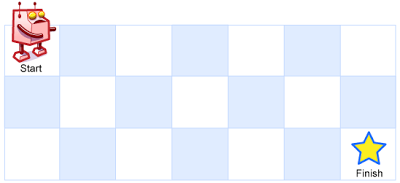There is a robot on an m x n grid. The robot is initially located at the top-left corner (i.e., grid[0][0]). The robot tries to move to the bottom-right corner (i.e., grid[m - 1][n - 1]). The robot can only move either down or right at any point in time.
Given the two integers m and n, return the number of possible unique paths that the robot can take to reach the bottom-right corner.
The test cases are generated so that the answer will be less than or equal to 2 * $10^9$.
Example 1:

Input: m = 3, n = 7
Output: 28
Example 2:
Input: m = 3, n = 2
Output: 3
Explanation: From the top-left corner, there are a total of 3 ways to reach the bottom-right corner:
1. Right -> Down -> Down
2. Down -> Down -> Right
3. Down -> Right -> Down
Constraints:
1 <= m, n <= 100
給定一個整數 m 還有一個整數 n
假設從座標 0, 0 走到 座標 m-1, n-1 的只能往下走或是往右走
求從 座標 0, 0 走到 座標 m-1, n-1 的所有走法的方法數
思考如果要從 座標 0, 0 走到 座標 m-1, n-1
不管如何走, 最後都是 要走 m-1 個單位往下走, n-1 個單位往右走
所以相當於是在找 m-1 個往走與 n-1 個往右走的排列並且去掉重複的組合
另一個思考方向是考慮要走到 m-1, n-1
由於只能往下跟往右
定義 dp[i,j] = 從 0,0 走到 i-1, j-1 的方法數
則有以下關係式
dp[i, j] = dp[i-1, j] + dp[i, j-1]
走到 i,j 的方法數 = 走到 i-1, j 的方法數(最後一步往下) + 走到 i, j-1 的方法數(最後一步往右)

時間複雜度 O(m*n)
空間複雜度 O(m*n)
package sol
func uniquePaths(m int, n int) int {
dp := make([][]int, m)
for row := range dp {
dp[row] = make([]int, n)
}
for col := 0; col < n; col++ {
dp[0][col] = 1
}
for row := 0; row < m; row++ {
dp[row][0] = 1
}
for row := 1; row < m; row++ {
for col := 1; col < n; col++ {
dp[row][col] = dp[row-1][col] + dp[row][col-1]
}
}
return dp[m-1][n-1]
}
